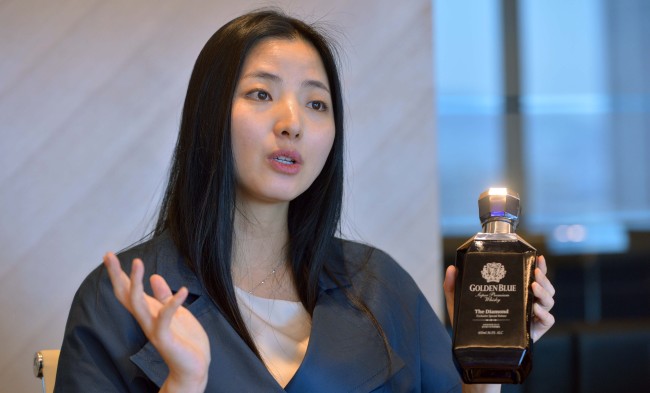Whiskey consumption in Korea has always been tied to a very specific culture: drink-till-you-drop parties among businessmen who enjoy coupling the expensive drink with women in smoky underground bars.
As that culture waned, so did whiskey sales. Its consumption in Korea has been falling by roughly three percent each year for the past five years, according to industry statistics.

Golden Blue regional sales director Kim Ji-yeon speaks to The Korea Herald at the Golden Blue headquarters in Seoul. (Lee Sang-sub/The Korea Herald)
And according to Kim Ji-yeon, sales director for home-grown spirit manufacturer Golden Blue, the market will not pick up again.
“We are seeing a change in the consumers who look for whiskey, and as a whole, the market will remain on a downtrend,” Kim told The Korea Herald at the Golden Blue headquarters in Seoul.
Her negative outlook might come as a surprise to some who remember Korea as one of the top consumers of super premium whisky aged 17 years or more. But she said that the apparent preference for high-end whiskey had partly been a result of Korea’s unique whiskey-drinking environment.
“Simply put, there is dwindling demand for high-end hostess bars,” Kim said.
Instead, people are increasingly buying high-quality whiskey to drink at home with family or friends.
Reflecting the new trend, single malt whiskey sales rose more than 5 percent in 2015, compared to an industrywide sales decline of 2.2 percent, according to the Korea Alcohol and Liquor Industry Association.
At the same time, whiskey with lower alcohol content is also gaining popularity.
After the boom in light and fruit-flavored soju last year, whiskey makers followed suit. French whiskey maker Pernod Ricard released the Eclat by Imperial, with 31 percent alcohol content, and Diageo unveiled the W Ice and W Rare by Windsor lines that have alcohol content of 35 percent.
“We unwittingly became the first in the industry to push for low-alcohol whiskey-like spirits,” Kim said, saying that the new trend presented an opportunity for Golden Blue to increase its recognition.
That’s because from the start, Golden Blue whiskey had featured an alcohol content of 36.5 percent, compared to the industry standard of 40 percent.
“We’re really pushing to increase our presence in casual bars, clubs, and retailers, beyond the traditional hostess bars this year,” she said. “Our market share is pretty high in the North and South Gyeongsang provinces, but this year we really need to make a splash in Seoul.”
Looking back, the 36-year-old says Golden Blue has come a long way.
Over the past 14 years she has spent in the whiskey industry, Kim has spent many nights knocking on doors of hostess bars in the affluent Gangnam business district. She says that at 22, she took the job because of its short hours and relatively high pay, without realizing the type of industry she was getting herself into. There were many instances when bar owners and customers would grab her, mistaking her for a hostess. Some establishments would throw her out because they believed it was bad luck to do business with a woman.
She also learned about the closed nature of the industry.
“Wherever I went, it was either Windsor or Imperial,” she recalled. “Bar owners often wouldn’t even give me a chance because they knew their customers would stick to what they liked. It was a long process to get them to even try Golden Blue, let alone put it into stock.”
Kim is not too optimistic about the future of the local whiskey market as she says that its so-called “golden age” is over, but she does believe whiskey lovers won’t disappear just yet, especially if manufacturers work to pick up on new drinking trends.
By Won Ho-jung (
hjwon@heraldcorp.com)




![[KH Explains] No more 'Michael' at Kakao Games](http://res.heraldm.com/phpwas/restmb_idxmake.php?idx=645&simg=/content/image/2024/04/28/20240428050183_0.jpg&u=20240428180321)

